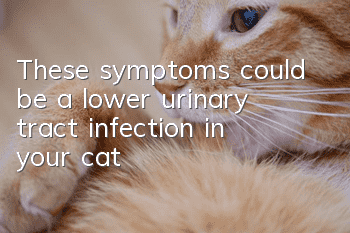These symptoms could be a lower urinary tract infection in your cat!

When scavengers usually take care of cats, they find that the cat suddenly doesn’t like to use cat litter and likes to urinate outside the litter box repeatedly. Some scavengers may think that the cat is getting angry with him because he has not taken good care of him. In fact, this is not the case. It is likely a danger sign that your cat has a lower urinary tract infection.
Lower urinary tract infection:
A lower urinary tract infection is an inflammation of the bladder, urethra, and urethral opening caused by bacterial infection.
1. Symptoms
·Frequent urination, poor urination, groaning during urination, and hematuria
·Licking the anus and genitals
·Abnormal urination behavior
·Lack of energy
·Vomiting and loss of appetite
Clinical signs of feline lower urinary tract disease vary depending on the disease and organ involved. Clinical signs are easier to see in cats that live indoors all the time, but less easily in cats that live primarily outdoors.
2. Diagnosis
· Palpation
When palpating the cat's posterior abdomen, if the cat does not urinate for a long time, the urethra may be completely blocked and the abdominal wall can be felt to be tense
· Urine color
Normal urine appears light yellow to amber due to the presence of urochrome. The depth of color is usually closely related to the dilution and concentration of urine. In clinical practice, diseases of the genitourinary system often cause blood in the urine.
· Urine turbidity
Normal cat fresh urine is transparent or clear, but due to the occurrence of disease, the transparency of urine decreases. The presence of crystals, casts, cells, bacteria, and contamination from external containers make the urine turbid. Suspended particles in the urine can even It can be observed with the naked eye.
· Smell
In addition to the occurrence of certain diseases that can cause a special smell in urine, in general, cat urine, especially male cat urine, will have a characteristic pungent smell. The smell of urine is not significant in diagnosing the disease.
·Urine pH
pH value is an indicator for testing the acidity and alkalinity of urine. Use pH test paper to detect urine. When the pH value is less than 7.0, the urine meterIt is acidic now, and when it is greater than 7.0, it is alkaline. When measuring the pH value, the urine to be measured must be fresh. Drop the urine on the test paper and determine the pH of the urine according to the color mark on the pH test paper package.
· Abnormal behavior
Such as licking the anus and genitals, abnormal urination behavior, frequent urination, and poor urination.
· B-ultrasound, X-ray and laboratory examination in pet hospital
If the cat only has symptoms in the urinary tract, it indicates cysto-urethritis; if the cat has systemic symptoms such as matte coat and weak body, it indicates partial or complete urethral obstruction. Male cats are generally more likely to develop it than female cats, with castrated (neutered) male cats and long-haired cats (especially Persian cats) having the highest incidence rates. Urinary tract obstruction is more common in male cats, while cystitis and urethritis are more common in female cats.
Causes of symptoms:
· Infections caused by microorganisms such as diseases or bacteria
Tumors, trauma, vesico-urachal diverticulitis, neurological disorders and other diseases can cause inflammation of the cat's lower urinary tract or similar symptoms. Inflammation of the lower urinary tract in cats usually reduces the body's resistance, allowing bacteria to grow and multiply in the urethra and bladder.
· Urinary tract structural abnormalities
The male cat's urethra is thin and long, with the bulbourethral gland and penis being the two narrowest and most prone to obstruction. Structural abnormalities of the urinary tract such as bladder diverticula and bladder agenesis can also easily lead to urinary tract infections and stones. Urethral stricture caused by scar tissue growth can also cause inflammation of the lower urinary tract in cats.
· Diet structure and nutrition
The pet's diet structure is unreasonable and the diet is relatively simple. Frequent feeding of high protein errors can easily lead to an imbalance in the calcium and magnesium ratio, which can easily lead to the formation of crystals and stones. Dry cat food with a high fiber content is difficult to digest, causing an overall increase in magnesium intake and causing stones. Long-term feeding of large amounts of dry cat food can cause The increase in feces and the increase in water excreted from the body through feces will lead to a decrease in cat urination, causing an increase in the concentration of magnesium in bladder urine, resulting in storage in the bladder and urethra, causing stones and inflammation; failure to drink enough fresh water can also Can cause lower urinary tract diseases.
· Neurological factors
Lower urinary tract infections in some cats are caused by neurological factors, such as bladder paralysis, urethral spasm, and abnormal coordination of urinary tract contractile muscles.
· Iatrogenic factors
Detection of urinary catheters, irregular use of urinary catheters, inappropriate urinary catheter models, reuse of urinary catheters, reverse flushing through urinary catheters, and related surgical catheters and urethras left in the bladder and urethra Urethral mucosal damage, urethral rupture or bacterial infection caused by ostomy, etc. can cause proliferative stricture of the urethra and cause lower urinary tract disease in cats.
·Urine pH
The ideal measurement time for urine pH is within 4-8 hours after the cat eats. Under normal circumstances, the pH value of cat urine should be maintained between 6.2-6.4. Such pH value of urine is not conducive to crystallization and The production of stones, thereby reducing the occurrence of lower urinary tract infections. The pH of cat urine is largely affected by the cat's diet. The pH of many standard cat foods will increase after the cat eats.
· Urethral obstruction
In clinical practice, crystals and stones are the most common causes of obstruction in the lower urinary tract of cats. The conditions for the formation of crystals and stones include: excessive salt content in urine, long-term retention of urine, appropriate pH and urine when salt forms crystals. The content of substances in the liquid that inhibit crystal formation is reduced.
· Other factors
The cat's obesity makes the cat lazy and unwilling to exercise, which leads to the cat's unwillingness to urinate and the frequency of urination decreases, resulting in urine storage. Some cats are prone to anxiety and dislike their dirty water basins and litter boxes, resulting in less water drinking and no urination. In addition, castration surgery, cold weather, stress, and stale drinking water can all be causes of urinary tract infections in cats.
Basic treatment for families:
During treatment, conservative therapy and surgical therapy are performed depending on whether the cat’s lower urinary tract is blocked
Conservative treatment includes urinary catheterization, dietary treatment, and symptomatic treatment. Usually the owner can only adopt dietary treatment and medication.
· Dietary processing
Change the diet structure before the onset of the disease, reduce the intake of high-protein foods, and feed a variety of nutritious cat foods; avoid excessive intake of magnesium, phosphorus, calcium, and chlorine, and feed low-magnesium prescription foods. Control the frequency of feeding, eat small meals frequently, feed nutritional paste appropriately, and encourage drinking plenty of fresh water.
Note: When buying cat food, try to choose cat food produced by large factories. The quality is guaranteed and the packaging is exquisite, with specially designed and manufactured moisture-proof bags. When purchasing, pay attention to the nutritional ingredients list behind the packaging bag. The protein content of high-quality cat food is 21% to 24%, and the ingredient list includes fish, chicken and other animal proteins, fatThe fat content is 8%~16%, moisture is 10%, fiber is 3%~4%, calcium is 1.5%, and phosphorus is 1%
· Medication
You can apply chlortetracycline or mycin ointment to the urethral opening and external genitalia; Sunuo (twice a day, half a tablet each time), Miuretong (once a day, one tablet each time), Urinary Tongshu (twice a day, 1/4 piece each time)
Note: If the cat is seriously infected, it is recommended to send it to the hospital for infusion and anti-inflammation. If urethra obstruction occurs, surgery should be performed in time.
Precautions for cats after surgery:
· Diet care
For cases that have just undergone surgery, it is difficult to give food due to the effect of anesthesia. You can drink a small amount of water to moisten the mouth. When you can feed food, it is recommended to give prescription food, eat small meals frequently, and add some nutritional paste if necessary. The drinking water should be kept fresh and sufficient. If the cat can accept wet food, the cat food can be soaked in water before feeding.
· Postoperative environment
After surgery, the cat's environment should be kept clean and hygienic, and the cat can be placed on a clean diaper. The ambient temperature is suitable. If the cat's body temperature drops, a warm water bottle can be placed next to the cat. Make sure to replace cat litter with new ones in a timely manner, clean and disinfect items used by cats, and avoid vigorous exercise to prevent wounds from opening.
· Medication Support
To promote stone elimination, traditional Chinese medicine such as Bazheng Powder can be given to prevent stones. Fossil medicine: "Money Fossil Capsule": composed of Desmodium chinensis, mallow seeds, morning glory seeds, black medicine, Achyranthes bidentata, sea golden sand, cork, gallinaceae, rhubarb, woodworm, licorice shoots, etc. Orally take 1 capsule/10kg body weight once, 2 times a day. Take it for 3 weeks and take a week off until the disease is cured.
· Wound Care
Cats after surgery should wear Elizabethan collars to prevent chewing wounds. The wound should be disinfected every day and kept dry after cleaning.
How parents can prevent cats from getting infected:
· To understand the daily living habits of sick cats, fat cats should be encouraged to exercise more and cats should be encouraged to urinate in a clean litter box.
· Optimize the cat’s dietary structure, feed less high-protein food, and feed it a prescription diet that is low in magnesium and acidifies urine. Drinking water should be fresh and sufficient. If necessary, you canPlace more water basins in places your cat likes.
· Change cat litter in time to ensure clean urination and defecation. The feeding environment should be kept constant to reduce unnecessary stimulation and stress.
· Conduct regular physical examinations on sick cats to ensure early detection and resolution of problems.
Lower urinary tract infections in cats are usually caused by unreasonable diet and poor living environment. Grasping the source of the disease can effectively prevent the occurrence of lower urinary tract infections.
Tips:
If parents have time, they can also give cats traditional Chinese medicine for urinary tract infections, painful urination, and hematuria, which also has good curative effects.
· Prescription 1
"Bazheng Powder" additions and subtractions: 6g each of Akebia and Talc (cloth bag), 3g each of Plantago Seed, Echinacea, Qumai, Honeysuckle, Gardenia, Forsythia, Phellodendron, and Rhubarb, decoct in water and take.
· Prescription 2
Addition and subtraction of "Xiaojiyinzi" combined with "Bazhengsan": 6g each of Xiaoji and talc (cloth bag), 4g of fried cattail, 15g of fresh grass root, 6g each of Rehmannia glutinosa, Akebia, Qumai, Angelicae Sinensis and Licorice root, water Decoct and take.
Administration method: After boiling the Chinese medicine, mix it with cat food. If the smell of the medicine is too strong and the cat is unwilling to take it, then give it in small amounts and multiple times.
- What should I do if my cat accidentally smells Fengyoujing? What's the harm?
- How to prevent cat ringworm in your daily life?
- Will a cat die if he eats potato chips?
- What causes vomiting in cats after vaccination?
- Are red tabby exotic shorthair cats easy to raise?
- What age is the best age to neuter a Chartreuse cat?
- How to Trim North American Shorthair Cat Nails
- What harm does secondhand smoke do to pets? Know how to prevent pets from being exposed to second-hand smoke
- Are civet cats only found in China?
- Do stray cats eat ham?



